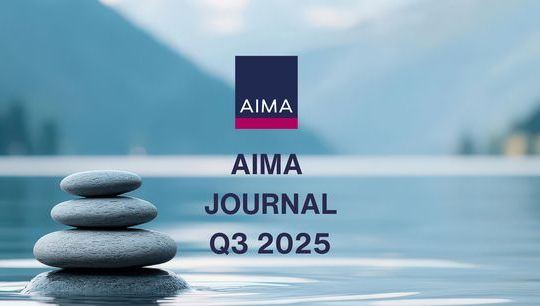Beyond 60-40: The evolving role of hedge funds in institutional investor portfolios
By AIMA
Published: 01 May 2013
The following is an online summary of this particular AIMA paper
Foreword
The paper sets out to explain why traditional portfolio construction techniques have been revisited by many investors since the crisis and what some of the new thinking in that space involves, including the role of alternatives in general and hedge funds in particular in the portfolios of tomorrow.
I am delighted to introduce on behalf of the AIMA Investor Steering Committee (ISC) our new paper, Beyond 60/40: The evolving role of hedge funds in institutional investor portfolios.
The paper is based on a survey of some of the most influential institutional investors in hedge funds globally. It sets out to explain why traditional portfolio construction techniques have been revisited by many investors since the crisis and what some of the new thinking in that space involves, including the role of alternatives in general and hedge funds in particular in the portfolios of tomorrow. It also seeks to dispel some common misconceptions about hedge funds and hedge fund investing.
In the paper, we wanted to hear directly from the hedge fund investors. One of the things that they explain in their detailed responses — which are quoted from liberally throughout the paper — is why they have invested in hedge funds. Many of them have either invested in hedge funds since the crisis for the first time, or have increased their allocations. Many spoke of their desire to apportion more of their overall portfolios to hedge funds in the coming years. Where the investors were somewhat critical — whether over fees, say, or governance — it was important that these criticisms also be included.
Although the sub-title of the paper refers to the “role” (singular) that hedge funds play in the investors’ portfolios, one of the key findings of our survey is that hedge funds continue to perform a variety of different roles (plural). Superior riskadjusted returns are still, and always will be, essential. But our fellow investors also spoke of their desire to tap into other potential benefits, including capital preservation, reduced portfolio volatility and increased diversification.
The lengths that institutional investors methodically take in reaching their investment decisions are also acknowledged in the paper. Investors devote enormous amounts of time and resources to researching new investment opportunities, risk profiles and strategies, and in undertaking the subsequent due diligence.
I would like to express our gratitude to the investors for devoting so much of their time to this initiative.
I would like to thank AIMA, on behalf of the ISC, for their continued commitment to investorengagement. Particular thanks are also due to Théodore Economou, CEO & Co-CIO, CERN Pension Fund; Sajal Jagdish Heda, Investment Manager, Al Omran Group; Elizabeth M. Hewitt, Director of Public Investments, Robert Wood Johnson Foundation; David Morehead, Director of Investments, Baylor University; and Andrew Waring, Chief Executive, MNOPF; for their help and support.
The ISC has been responsible for a number of useful publications in recent years, including the Roadmap to Hedge Funds, the world’s first educational guide for institutional investors in hedge funds, and the Guide to Institutional Investors’ Views and Preferences Regarding Hedge Fund Operational Infrastructures, which set out investors’ views, expectations and preferences on a variety of important operational and organisational issues.
We hope that you enjoy reading this paper and find it to be as useful a reference tool as those earlier ISC publications.
Michelle McGregor-Smith
Chief Executive, British Airways Pension Investment Management Ltd
Member, AIMA Investor Steering Committee
Executive summary
This paper, by AIMA’s Investor Steering Committee (ISC), is based on a survey of institutional investors worldwide about their hedge fund investments.
The investors provided detailed responses to a range of questions about their investment decisions and processes, and excerpts from those responses appear throughout the paper. The questions themselves are included in the appendix.
The respondents included North American, Asian and European pension funds, endowments, foundations and family offices. Their combined assets are more than $400 billion.
The main findings of the survey include:
- Institutional investors are moving away from the traditional 60/40 portfolio structure and increasingly using alternatives in general and hedge funds in particular as tools to customise their portfolios.
- Hedge funds are increasingly regarded as a means to access opportunities and tailor portfolios, rather than as a separate asset class.
- Investors are using hedge funds to enable them to meet individual objectives in terms of risk-adjusted returns, diversification, lower correlations, lower volatility and downside protection.
- Most investor respondents said they had increased their allocations to hedge funds since the financial crisis, with some reporting a doubling of their allocations.
- Most of the respondents plan to continue to increase their allocations to hedge funds in the future.
- Hedge fund due diligence is taking longer, with one investor respondent saying it now can take up to two years to complete.
- The increasing emphasis placed by hedge funds on transparency since the crisis was generally welcomed. Investors said however that they did not want to be swamped with unnecessary information.
- Many of the investors welcome the increased regulation of the hedge fund industry since the crisis, including the additional reporting requirements to regulators. But some spoke of worries that the reforms could be onerous or restrict their ability to allocate to certain managers in certain jurisdictions.
- Asked what steps the hedge fund industry could take in order to attract new or increased investments, the investors cited lower fees, further transparency, additional changes to governance and further improvements to operational infrastructure.
- Larger hedge fund managers were generally attracting most of the institutional investment, but some investors were starting to explore ways of allocating to smaller, emerging managers.
- Investors would like to see hedge funds willing to take fewer clients and build stronger strategic partnerships with them.
Introduction
Hedge funds are increasingly being seen as tools to customise portfolios to enable investors to achieve individual objectives in terms of risk-adjusted returns, correlations, volatility, diversification and downside protection.
Institutional investors face an almost unprecedented set of challenges. The post-crisis period has been one of slow economic growth, low or effectively even negative interest rates, volatile markets and increasing geo-political pressures.
This set of conditions is threatening to undermine the viability of the traditional Markowitz portfolio model — the “60/40” model of a 60% allocation to domestic equities and 40% to high-grade corporate or government bonds. Equities may have been performing well recently, but investors have not forgotten the stock market falls of 40% in 2008, while some sovereign bonds are not yielding in real terms — indeed many investors effectively are paying governments for the privilege of lending them money. Put another way, assets that were once regarded as “risk-free” are now characterised in some quarters as “return-free”.
Institutional investors have been compelled to move away from the 60/40 structure and consider non-traditional approaches to investing. Faced with managing investment portfolio risk while at the same time identifying solutions that will generate sufficient portfolio returns to support their future liabilities, the need to employ diverse investment strategies is more important than ever.
Many investors now regard alternatives in general and hedge funds in particular as tools to customise their portfolios and enable them to achieve individual objectives in terms of risk-adjusted returns, lower correlations, lower volatility, greater diversification and more downside protection.
Hedge funds in general have recovered fairly well from the financial crisis. Total assets under management reached $2.4 trillion, a new record level, by the end of the first quarter of 2013.[1] New research in 2012 was able to demonstrate how hedge funds outperformed equities or fixed income over the long term.[2]
Institutional investors have been the main source of the industry’s asset growth since the crisis.[3] But why has so much money flowed into the industry at a time of relatively modest returns for many hedge funds?
This paper, by the members of AIMA’s Investor Steering Committee (ISC), sets out to answer this broad question.
We, the ISC, are a group of institutional investors in hedge funds globally. Our paper is the product of a survey of many leading institutional investors in hedge funds worldwide. The respondents include North American, Asian and European pension funds, endowments, foundations and family offices. We regard them as being among the most influential institutional investors in hedge funds, with combined assets of more than $400 billion. They were asked a series of questions about their hedge fund investments, including the size of their allocations and the role that hedge funds play in their portfolios.
We questioned them about the processes that they follow in making those allocations, including their due diligence and risk management requirements. And we invited them to suggest changes that the industry could make to encourage further increases in allocations.
[1] Hedge Fund Research, ‘HFR Global Hedge Fund Industry Report’, 19 April 2013
[2] The Centre for Hedge Fund Research, Imperial College, ‘The value of the hedge fund industry to investors, markets and the broader economy’, April 2012 (AIMA/KPMG)
[3] KPMG and AIMA, ‘The evolution of an industry’, May 2012







